|
 Secure Site
Secure Site
|
 |
Archive for the 'Well-being' Category
 Yoshitoshi, Geisha at a Flower Festival, 1880 - Snooze More Soundly Unplug in the evening. According to a National Sleep Foundation (NSF) survey, 95 percent of people use an electronic device, such as a computer, just before bedtime. “But that can cause you to toss and turn,” says Russell Rosenberg, Ph.D., NSF chairman and director of the Atlanta School of Sleep Medicine. “The bright light from the screen delays the release of melatonin, a sleep-promoting hormone.” To snooze more soundly, switch off technology and try dimming the lights an hour before you aim to sleep.
 Snooze More Soundly Our Digital Zen Clock’s long-resonating Tibetan bell-like chime makes waking up a beautiful experience – its progressive chimes begin your day with grace. When the clock’s alarm is triggered, the acoustic chime bar is struck just once … 3-1/2 minutes later it strikes again … chime strikes become more frequent over 10 minutes … eventually striking every 5 seconds until shut off. As they become more frequent, the gentle chimes will always wake you up – your body really doesn’t need to be awakened harshly, with a Zen Clock you’re awakened more gradually and thus more naturally.
Unlike artificial recorded sounds coming out of a tiny speaker in a plastic box, natural acoustic sounds transform your bedroom or office environment.
The Digital Zen Clock also serves as a countdown and interval timer for yoga, meditation, bodywork, etc.; and it can also be set to chime on the hour as a tool for “mindfulness.”
Digital Zen Clocks feature a “high” and “low” chime strike volume control, which allows you to adjust the sound of the chime to suit your needs. The Digital Zen Clock runs on 2 AA batteries (not included) and can also be plugged in with the included AC jack. The clock includes a lighted digital display (which can be set to be lit full-time when plugged in).
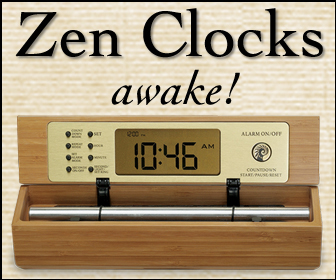 Gentle Chime Alarm Clocks for a Progressive Awakening Now & Zen’s Gentle Chime Alarm Clock Store
1638 Pearl Street
Boulder, CO 80302
(800) 779-6383
Posted in Bamboo Chime Clocks, sleep, Sleep Habits, Well-being
 How Do We Find Balance in Life - Harunobu Suzuki, A girl Collecting Chrysanthemum Dem by the Stream The art of life balance requires creativity. If you push too hard you will miss its subtle rewards. Navigating easily through life requires a sense of curiosity and playfulness, like that of a child. This doesn’t excuse you from taking life seriously, simply that you release the illusion that you can control everything. By exerting control over everything, you may end up limiting yourself. The art of life balance requires dedicated time for having fun and observing the world around you. You may be surprised at what you find if you do.
 Meditation - A Stillness Practice Try a Stillness Practice Like Meditating:
Meditation is generally an inwardly oriented, personal practice, which individuals do by themselves. Meditation may involve invoking or cultivating a feeling or internal state, such as compassion, or attending to a specific focal point. The term can refer to the state itself, as well as to practices or techniques employed to cultivate the state. There are dozens of specific styles of meditation practice; the word meditation may carry different meanings in different contexts. Meditation has been practiced since antiquity as a component of numerous religious traditions. A 2007 study by the U.S. government found that nearly 9.4% of U.S. adults (over 20 million) had practiced meditation within the past 12 months, up from 7.6% (more than 15 million people) in 2002.
Although meditation can be done in almost any context, practitioners usually employ a quiet, tranquil space, a meditation cushion or bench, and some kind of timing device to time the meditation session. Ideally, the more these accoutrements can be integrated the better. Thus, it is conducive to a satisfying meditation practice to have a timer or clock that is tranquil and beautiful. Using a kitchen timer or beeper watch is less than ideal. And it was with these considerations in mind that we designed our digital Zen Alarm Clock and practice timer. This unique “Zen Clock” features a long-resonating acoustic chime that brings the meditation session to a gradual close, preserving the environment of stillness while also acting as an effective time signal. The Digital Zen Clock can be programmed to chime at the end of the meditation session or periodically throughout the session as a kind of sonic yantra. The beauty and functionality of the Zen Clock/Timer makes it a meditation tool that can actually help you “make time” for meditation in your life.
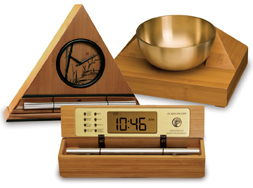 Timers for Meditation and Yoga - Progressive Acoustic Chimes
Now & Zen’s Meditation Timer Store
1638 Pearl Street
Boulder, CO 80302
(800) 779-6383
Posted in Bamboo Chime Clocks, wake up alarm clock, Well-being, Yoga Timer, Yoga Timers by Now & Zen
 Why Do Some People Need More Sleep? New research suggests it is in our genes…
Some people are genetically programmed to need less sleep than the rest of us, according to a new paper published this week in Science. A rare genetic mutation lets its carriers function happily and healthily even with hours less sleep each night than doctors normally recommend.
Researchers discovered the enviable gene variant after studying a family in which two members, a mother and a daughter, seemed to need much less daily rest than their close relatives. The women slept just 6.25 hours per night, while others in the family averaged 8.06 hours. The researchers then sequenced some genes they thought could be responsible, and discovered that both mom and daughter — unlike others in the family — had a never-before-seen mutation in a gene that’s known to affect circadian rhythms.
Next, to test whether that gene variant was really the cause of mom and daughter’s shortened sleep time (and not just some freak coincidence), the researchers genetically engineered a group of mice to express the newly found mutation. Sure enough, those mice had a typical activity period that’s more than an hour longer, on average, than that of a normal mice. The mutant mice also seemed to need less catch-up sleep than others after a period of sleep deprivation.
The new findings give a fascinating insight into why humans vary so much in how long we sleep — with a good night’s shut-eye ranging anywhere from six hours to nine, depending on whom you ask. But the result can hardly explain everything. This new-found gene variant appears in just 1 in 60 families that were studied, according to a follow-up paper that’s also published this week in Science. For genes to explain the full range of human sleep needs, then, there would have to be other genes involved too.
adapted from Time.com, by Laura Blue
Our Digital Zen Clock’s long-resonating Tibetan bell-like chime makes waking up a beautiful experience – its progressive chimes begin your day with grace. When the clock’s alarm is triggered, the acoustic chime bar is struck just once … 3-1/2 minutes later it strikes again … chime strikes become more frequent over 10 minutes … eventually striking every 5 seconds until shut off. As they become more frequent, the gentle chimes will always wake you up – your body really doesn’t need to be awakened harshly, with a Zen Clock you’re awakened more gradually and thus more naturally. Unlike artificial recorded sounds coming out of a tiny speaker in a plastic box, natural acoustic sounds transform your bedroom or office environment.
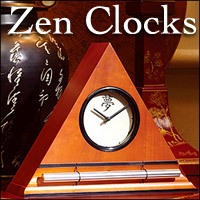 The Zen Alarm Clock transforms mornings, awakening you gradually with a series of gentle acoustic chimes Once you use a Zen Clock nothing else will do. Now & Zen – The Zen Alarm Clock Store
1638 Pearl Street
Boulder, CO 80302
(800) 779-6383
Posted in Bamboo Chime Clocks, Chime Alarm Clocks, sleep, Sleep Habits, Well-being
 Dreams May Useful in Resetting Our Emotional Compass - Yoshitoshi Taiso Dreams may not be the secret window into the frustrated desires of the unconscious that Sigmund Freud first posited in 1899, but growing evidence suggests that dreams — and, more so, sleep — are powerfully connected to the processing of human emotions.
According to new research presented last week at the annual meeting of the Associated Professional Sleep Societies in Seattle, adequate sleep may underpin our ability to understand complex emotions properly in waking life. “Sleep essentially is resetting the magnetic north of your emotional compass,” says Matthew Walker, director of the Sleep and Neuroimaging Lab at the University of California, Berkeley.
REM sleep appears to not only improve our ability to identify positive emotions in others; it may also round out the sharp angles of our own emotional experiences. Walker suggests that one function of REM sleep — dreaming, in particular — is to allow the brain to sift through that day’s events, process any negative emotion attached to them, then strip it away from the memories. He likens the process to applying a “nocturnal soothing balm.” REM sleep, he says, “tries to ameliorate the sharp emotional chips and dents that life gives you along the way.
 Can Dreams Improve Our Emotional Life? adapted from Time.com, by Tiffany Sharples
Boulder, Colorado—an innovative company has taken one of life’s most unpleasant experiences (being startled awake by your alarm clock early Monday morning), and transformed it into something to actually look forward to. “The Zen Alarm Clock,” uses soothing acoustic chimes that awaken users gently and gradually, making waking up a real pleasure. Rather than an artificial recorded sound played through a speaker, the Zen Clock features an alloy chime bar similar to a wind chime. When the clock’s alarm is triggered, its chime produces a long-resonating, beautiful acoustic tone reminiscent of a temple gong. Then, as the ring tone gradually fades away, the clock remains silent until it automatically strikes again three minutes later. The frequency of the chime strikes gradually increase over ten-minutes, eventually striking every five seconds, so they are guaranteed to wake up even the heaviest sleeper. This gentle, ten-minute “progressive awakening” leaves users feeling less groggy, and even helps with dream recall.
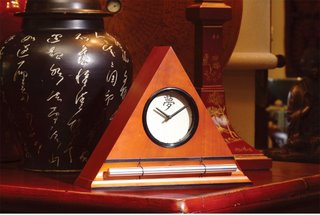 Gentle Chime Alarm Clocks for a Progressive Awakening Now & Zen – The Chime Alarm Clock Store
1638 Pearl Street
Boulder, CO 80302
(800) 779-6383
Posted in Bamboo Chime Clocks, sleep, Sleep Habits, wake up alarm clock, Well-being
 why we need the sun The sun is the center of our lives. It gives us day and night, seasons, light, heat, colors, wind, plant life, moonlight and a sense of direction and time of day—not to mention awesome sunrises and sunsets. Solar heating, daylighting, and solar electricity reduce our dependence on nonrenewable energy sources. And the absence of sunshine can be debilitating, as any sufferer of Seasonal Affective Disorder (SAD) can attest. Yet sunlight can degrade fabrics, overheat our homes, encourage cataracts, and cause our skin to age and develop cancer. We are urged to go outside only under cover of hats, sunglasses, sunscreens, and tightly woven fabrics. What we rarely hear is that sunshine is also an important element of good health.
Why we need sunlight
According to Zane Kime, M.D., M.S., in Sunlight (World Health Publications, 1980), the ultraviolet (UV) portion of sunlight helps our heart, blood chemistry, immune system, energy level, and sex life, while its absence weakens our body’s systems and contributes to disease. Furthermore, we rely on the sun’s daily and annual cycles to regulate such bodily functions as heart rate, blood pressure, hormone levels, metabolism, and immunity. When modern living throws our biological rhythms out of synch with solar rhythms, the results can be fatigue, depression, insomnia, digestive problems, poor coordination, loss of mental ability, and loss of sex drive and fertility.
Sunlight also improves our attitudes and behavior. Studies have shown that students in daylit schoolrooms performed markedly better than their non-daylit peers. Daylit retail stores experienced increased sales, less absenteeism among employees, and fewer employee mistakes. One survey of indoor workers, from warehouse employees to upper management, found a strong correlation between job satisfaction and the amount of sunlight entering the workspace. There’s even a link between sunny mornings and positive stock market returns.
In addition to its health effects, we can all benefit from developing a richer relationship with the sun. Do you awaken gradually in the mornings with sunlight, or does an alarm clock interrupt your sleep cycles? Does sunshine enter the rooms where you spend your days? Do you get outdoors with some skin exposed every day? Do you notice that the color of the sun’s light is different in the morning, noon, and evening—different in summer and winter? Do you notice the sun’s path being higher in summer than in winter? Do you watch the sun rise or set?
If your life is less than sun-kissed, here are some suggestions. Learn to identify the compass directions, and observe the sun’s path across the sky regularly. Notice where sunlight falls at various times of day in your home, yard, and workplace. As appropriate, move furniture to bring your activities closer to daylight. Create a sculpture or sundial that makes the sun’s motion visible. Grow plants. Rise with the sun and slow down after sunset. Move some activities outdoors. Cultivate a life within walking distance of home. Listen to your body and mind to create your own right relationship with the sun.
CAROL VENOLIA is an architect, author of Healing Environments: Your Guide to Indoor Well-Being.
adapted from Natural Home Magazine, July/August 2002
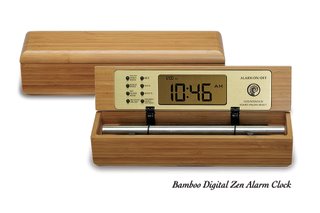 Portable Meditation Timer and Yoga Clock Use our unique “Zen Clock” which functions as a Yoga & Meditation Timer. It features a long-resonating acoustic chime that brings your meditation or yoga session to a gradual close, preserving the environment of stillness while also acting as an effective time signal. Our Yoga Timer & Clock can be programmed to chime at the end of the meditation or yoga session or periodically throughout the session as a kind of sonic yantra. The beauty and functionality of the Zen Clock/Timer makes it a meditation tool that can actually help you “make time” for meditation in your life. Bring yourself back to balance.
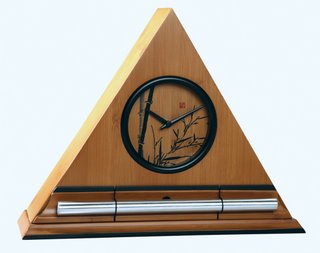 alarm clocks with chime for a gentle awakening
Now & Zen – The Zen Timer & Alarm Clock Store
1638 Pearl Street
Boulder, CO 80302
(800) 779-6383
Posted in Well-being
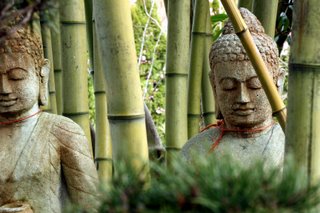 creating sacred spaces Meditation and other spiritual practices are basic to enhancing energy—they create balance and improve the quality of your home or office. In fact, the best thing you can do to create a sacred santuary (to improve the supportiveness of a space) is to do spiritual practices (sadhana). Prayer, meditation, yoga, chanting, and pranayama all enliven a space.
Be consistent with the spiritual practices of whatever tradition you are drawn to. As the Sufi poet Rumi said, your true home is within and reachable by letting go and allowing the mind to go inward. When we feel at home within ourselves and within our own hearts, any building we live in will feel more serene and supportive. Meditation practices make us more perceptive of our environment, so that we intuitively know many of the changes to make. We become more in touch, literally and metaphorically. According to Vastu, the northeast or the center of the home is the best area for meditation rooms, spiritual altars, and yogic practices.
adapted from Yoga Internation by Sherri Silverman
Use our unique “Zen Clock” which functions as a Yoga & Meditation Timer. It features a long-resonating acoustic chime that brings your meditation or yoga session to a gradual close, preserving the environment of stillness while also acting as an effective time signal. Our Yoga Timer & Clock can be programmed to chime at the end of the meditation or yoga session or periodically throughout the session as a kind of sonic yantra. The beauty and functionality of the Zen Clock/Timer makes it a meditation tool that can actually help you “make time” for meditation in your life. Bring yourself back to balance.
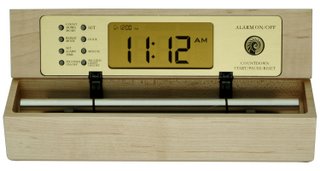 tools for meditation, zen timer Now & Zen – The Yoga Timer & Clock Store
1638 Pearl Street
Boulder, CO 80302
(800) 779-6383
Posted in Feng Shui, Meditation Timers, Meditation Tools, mindfulness practice, Well-being
 finding balance Myth: Balance is effortless.
Truth: Balance is efficient.
In physics, equilibrium is a state in which all external forces cancel each other out, with no one force exerting dominance over the other. That’s how balance can work, too; it’s not that you’re not exerting any effort, it’s that you’re providing just the right amount for each need.
When you’re balanced, your exertion is distributed so well — your big muscles doing the big work and your little muscles carrying a lighter load — it feels effortless even though it’s anything but. One way to tune in to your balance is to appreciate your physical balance, whether through running, walking, or doing yoga or any activity that calls for focus.
adapted from Body + Soul
Although meditation can be done in almost any context, practitioners usually employ a quiet, tranquil space, a meditation cushion or bench, and some kind of timing device to time the meditation session. Ideally, the more these accoutrements can be integrated the better. Thus, it is conducive to a satisfying meditation practice to have a timer or clock that is tranquil and beautiful. Using a kitchen timer or beeper watch is less than ideal.
And it was with these considerations in mind that we designed our digital Zen Alarm Clock and practice timer. This unique “Zen Clock” features a long-resonating acoustic chime that brings the meditation session to a gradual close, preserving the environment of stillness while also acting as an effective time signal.
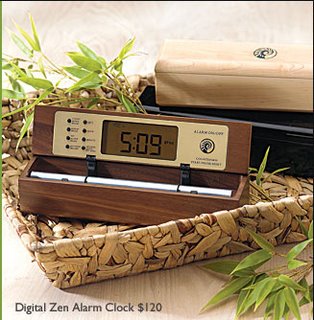 timers for finding balance in your life
Now & Zen – The Chime Meditation Timer Store
1638 Pearl Street
Boulder, CO 80302
(800) 779-6383
Posted in Meditation Timers, Meditation Tools, mindfulness practice, Well-being
 Five ways to change your brain Five Ways to Change Your Brain
1. Redecorate a room in your home — move things around so you interact with the space in a slightly different way.
2. If you’re left-brained, or rigidly organized, experiment with allowing for some comfortable disarray
3. If you’re right-brained, try adopting some organizational systems for your home or office that will help you access information you need that you can never find.
4. Ask yourself what a friend would choose the next time you go shopping or redecorate.
5. Stop spending time on things you don’t need to do. A balanced life is really imbalanced. Spend more time doing what you love.
adapted from Body + Soul, Text by Terri Trespicio
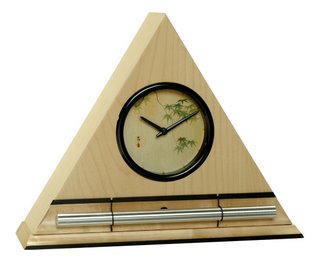 gentle wake up clocks with chimes Testing yourself is one of the best ways to get a feel for balance — which is why a great way to experience balance in your life is to change the way you do some normal, everyday things. Of course, changing everything at once is sure to throw you off, but try one thing at a time.
Although meditation can be done in almost any context, practitioners usually employ a quiet, tranquil space, a meditation cushion or bench, and some kind of timing device to time the meditation session. Ideally, the more these accoutrements can be integrated the better. Thus, it is conducive to a satisfying meditation practice to have a timer or clock that is tranquil and beautiful. Using a kitchen timer or beeper watch is less than ideal.
And it was with these considerations in mind that we designed our digital Zen Alarm Clock and practice timer. This unique “Zen Clock” features a long-resonating acoustic chime that brings the meditation session to a gradual close, preserving the environment of stillness while also acting as an effective time signal.
 The Zen Alarm Clock Store - Boulder, Colorado
Now & Zen – The Zen Alarm Clock Store
1638 Pearl Street
Boulder, CO 80302
800) 779-6383
Posted in Well-being
 Warm winter sun “Imagine yourself outside on a beautiful Saturday afternoon, just in the flow, enjoying life. Suddenly the sun disappears behind a cloud that you didn’t know was there. It’s dark now, and you feel off kilter, sad.”
That’s how LeNeva Spires, who works as an executive assistant at a university in Portland, Oregon, describes the seasonal affective disorder (SAD) that affects her every autumn.
Though classified as a type of depression, “it feels more like something is missing, like things are not quite right,” says Spires.
It’s precisely brightness (or rather, the lack of it) that triggers this mood disorder, one of few health problems tied to a season. SAD primarily affects people who live in northern latitudes (above San Francisco and Washington, D.C.), and more women than men. It often begins in September or October, as the days shorten, and lingers until spring.
SAD tends to respond readily to the very thing we’re missing in the winter months: light. Learn how to get more of it as well as discover the best foods, exercise, supplements, and herbs to create your action plan for a brighter, happier winter.
1. Let There Be Light
For seasonal depression and the winter blahs, “the treatment of choice is light,” says psychiatrist Alfred Lewy. How do you get that light? You could move closer to the equator, where the sun rises and sets at a more consistent time all year long. Or, if your family and work life allow it, you could change your sleep schedule during the winter so you wake up a half-hour after sunrise (check your local paper to find out when the sun rises), and then go immediately outside.
But for most of us, the easiest option is to purchase a light box outfitted with special bulbs that mimic the brightness of the morning sun. Light therapy works by getting our sleep-wake cycle to synchronize with an electric-powered “sun,” thereby resetting our circadian clock. We tend to feel our best when we wake with the dawn, and the light box essentially helps you make your own dawn.
Light-Box Lowdown
Available online and at specialty stores (starting at about $160), light boxes are safe to use at home, whether or not you have an official diagnosis of SAD. Lewy recommends placing the light box at a 45-degree angle to you, from either the side or above, and starting with a morning dose of light: about 30 minutes, taken between 6 a.m. and 8 a.m. Some people may need more time — 45 minutes, or even up to two hours — but once they feel an improvement in their mood, they can reduce the sessions to 30 minutes.
The light receptors that help rest our circadian clocks reside in our eyes, so keep your eyes open during light treatment. In fact, Lewy suggests glancing sideways at the lightbulbs once or twice every minute (something you should never do with the real sun).
A small number of SAD sufferers respond best to early-evening light treatments. After a week or two of morning treatment, if you notice no improvement even with two-hour doses, try the evening sessions instead, suggests Lewy. People usually begin to feel better within a few days but should keep up the treatments daily, ideally from the onset of symptoms (usually in September or October) through at least March.
 bring on the night 2. Bring On the Night
You need a good night’s sleep in order to mitigate winter depression — and by “good,” Emmons means sleeping for eight or nine hours a night — but not more. Keep bedtime and wake-up time consistent, too; Emmons suggests going to bed between 10 and 11 p.m. and rising between 6 and 7 a.m.
Melatonin Matters
While light-box therapy remains the primary remedy for synchronizing your sleep patterns, supplementing with melatonin (the “darkness” neurotransmitter) may help, too. The brain’s melatonin levels rise to their highest level at night, and people normally start secreting the hormone a few hours before bedtime, to prime the body for sleep.
Like light therapy in the morning, taking melatonin supplements in the afternoon can help shift the circadian clock. In fact, Lewy often prescribes both morning light and 0.3 mg to 0.5 mg of melatonin in the afternoon for best results in resyncing the circadian processes. Since melatonin can make some people sleepy, avoid driving as you figure out the best dosage. You’ll find melatonin tablets at natural-foods stores.
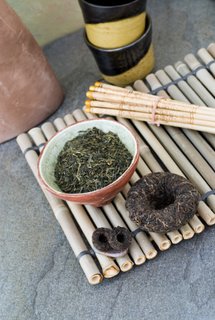 eat well 3. Eat to Feel Good
What we eat can affect our brain chemistry and our mood. To combat SAD, Emmons recommends focusing on foods that increase and stabilize levels of serotonin, a mood-improving hormone that tends to decrease in the winter. These foods include choices rich in tryptophan, a building block of serotonin.
We often crave high-carbohydrate comfort foods in winter, but it’s wise to resist the urge, he says. As he explains it, indulging in refined carbs, such as white bread and white rice, may indeed offer an initial feel-good spike in serotonin levels. But, as with a sugar rush, refined carbs end up depleting our serotonin levels soon after.
Instead, eat a variety of complex carbohydrates, such as barley, brown rice, oats, and other whole grains, and include a small amount of lean protein, ideally a high-tryptophan protein (turkey, cheese, eggs) at each meal or snack. Also include leafy green vegetables, such as kale and bok choy, which provide mood-supporting B vitamins and minerals that help convert tryptophan into serotonin.
4. Move and Stretch
“Exercise helps [all types of depression] for many reasons,” says Emmons. It boosts serotonin levels in the brain; it improves circulation, which gets more blood and nutrients to the brain; it increases energy and metabolism, even at the cellular level; and it improves glucose regulation, which also affects energy levels.
For those taking antidepressant medication, exercise helps improve the effectiveness of the drug, likely by improving circulation. More of the medicine gets to the brain, where it’s needed, and the body metabolizes the drug more easily, which reduces side effects.
The best news about SAD and exercise, says Emmons, is that you don’t have to take your workout to the extreme. Mild aerobic exercise for 30 minutes can usually lighten your mood. If it’s not too cold, walking outdoors is a great option. At the gym, try the stationary bike or treadmill for a half-hour every day.
5. Supplement Smartly
Several dietary supplements can help fill in any nutritional gaps and in turn may lift your mood. Emmons says his clients have had success with the following four:
Vitamin D
Deficiency in this vitamin is extremely common and may contribute to both ordinary and seasonal depression (along with other illnesses). While light boxes substitute for the sun in certain ways, they don’t provide this critical nutrient (which is more of a hormone than a vitamin). In the winter, a vitamin D supplement can help regulate your mood.
Dosage: 2,000 IU of vitamin D3 daily
Multivitamin
A good one includes plenty of B vitamins, as well as key minerals such as selenium (which helps support mood) and magnesium (which reduces anxiety and muscle tension).
Dosage: 1 daily
B-Vitamin Complex
These assist the brain in producing neurotransmitters such as serotonin and norepinephrine.
Dosage: One B-50 supplement daily (along with the multivitamin)
Omega-3-Rich Fish Oil
Studies suggest that omega-3 fatty acids may help prevent and ease depression and other mood disorders. Flax makes a good substitute for strict vegetarians.
Dosage: 1,000 mg of fish oil in capsule form twice daily, or 1 tablespoon of flax oil twice a day
6. Take It Outside
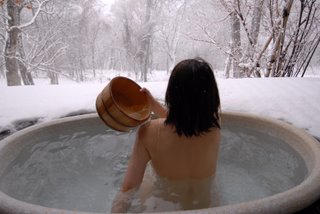 go outside to cheer up Spending time outdoors helps us reconnect with nature, says Emmons, thus healing a rift that seems to lie at the heart of seasonal depression. If you combine a serotonin-boosting exercise with your outdoor time — like a brisk walk at a local park or an afternoon of cross-country skiing — you’re combating the winter blues on two fronts.
During the summer, take advantage of the sunlight by spending 15 to 20 minutes a day in the sun without sunscreen (unless you’re at risk of skin cancer). This will help build your vitamin D levels for next year.
7. Try Healing Herbs
Certain medicinal plants ease the winter blues, says Margi Flint, who runs the Earthson Herbals school in Marblehead, Massachusetts.
Uplifting Tea
For a mild, mood-boosting infusion, simmer 1 ounce oatstraw in 1 quart of water for 40 to 60 minutes. Remove from heat, add 2 tablespoons of dried chamomile and 2 tablespoons of dried lemon balm; cover and steep for 15 minutes. Strain and drink several cups daily.
Aromatherapy
Since the smell of any citrus uplifts the spirit, add a total of 10 drops of any combination of lemon, lime, and orange essential oils to each ounce of lotion or massage oil. Use daily, or use these oils in a diffuser.
Daily Tonic
Holy basil, ashwaganda, and gotu dola — from India’s traditional system of medicine, Ayurveda — help ease depression. Flint suggests using the powdered form; add a 1/4 teaspoon of each to oatmeal or applesauce.
8. Don’t Go It Alone
As with any form of depression, working with a mental-health professional for SAD can be beneficial. If you experience suicidal thoughts or other serious symptoms, seek help immediately.
One of the ultimate Zen like experiences is waking-up from a great slumber refreshed and energized. Your mind and body are harmoniously one, both alert and focused. Having a refreshed mind and body are two keys to a natural and Zen lifestyle. Waking up in the morning should not be a loud and abrupt awakening, but rather it should be a peaceful positive experience. The right natural alarm clock can transition your deep and tranquil sleep into a serene start to consciousness. Imagine a long-resonating Tibetan bell-like chime waking you up to a beautiful morning experience.
The right alarm clock can be the most beneficial investment for you. With our Now & Zen natural alarm clock you are awakened more gradually and thus more naturally. Now & Zen is focused on creating a naturalistic lifestyle, and our clocks are an example of our philosophy.
adapted from Body + Soul, January/February 2009
 Bamboo Alarm Clocks & Meditation Timers
Now & Zen – Gradual Chime Alarm Clock Store
1638 Pearl Street
Boulder, CO 80302
(800) 779-6383
Posted in Goodness, Insomnia, intention, sleep, Sleep Habits, Well-being, Zen Timers
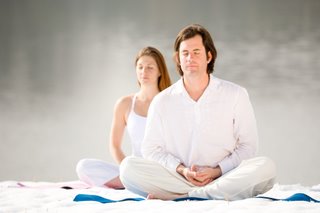 How to feel more compassionate Maitryadisu balani
The cultivation of friendliness creates inner strength. (Yoga Sutra III.24)
We typically think of our emotional range as something that is fixed and unchanging—a reflection of the personality we’re born with. But research is revealing the possibility that we may be able to cultivate and increase our ability to feel the emotional state of compassion. Researchers have found that feeling connected to others is as learnable as any other skill. “We are trying to provide evidence that meditation can cultivate compassion, and that you can see the change in both the person’s behavior and the function of the brain,” Lutz says.
So what does compassion look like in the brain? To find out, Lutz and his colleagues compared two groups of -meditators—one group whose members were experienced in compassion meditation, and the other a group whose members were not—and gave them the same instructions: to generate a state of love and compassion by thinking about someone they care about, extend those feelings to others, and finally, to feel love and compassion without any specific object. As each of the participants meditated in-side the fMRI brain scanners, they were occasionally interrupted by spontaneous and unexpected human sounds—such as a baby cooing or a woman screaming—that might elicit feelings of care or concern.
All of the meditators showed emotional responses to the sounds. But the more experienced compassion meditators showed a larger brain response in areas important for processing physical sensations and for emotional responding, particularly to sounds of distress. The researchers also observed an increase in heart rate that corresponded to the brain changes. These findings suggest that the meditators were having a genuine empathic response and that the experienced meditators felt greater compassion. In other words, compassion meditation appears to make the brain more naturally open to a connection with others.
These meditation techniques may have benefits beyond the experience of spontaneous compassion. A study by psychology professor Barbara Fredrickson and her colleagues at the University of North Carolina, Chapel Hill, and the University of Michigan, found that a seven-week lovingkindness meditation course also increased the participants’ daily experience of joy, gratitude, and hope. The more participants meditated, the better they felt. Participants also reported a greater sense of self-acceptance, social support, purpose in life, and life satisfaction, while experiencing fewer symptoms of illness and depression. This study provides strong evidence that chipping away at the illusion of separation can open us up to a far more meaningful connection to life.
adapted from Yoga Journal, by Kelly McGonigal
Use our unique “Zen Clock” which functions as a Yoga & Meditation Timer. It features a long-resonating acoustic chime that brings your meditation or yoga session to a gradual close, preserving the environment of stillness while also acting as an effective time signal. Our Yoga Timer & Clock can be programmed to chime at the end of the meditation or yoga session or periodically throughout the session as a kind of sonic yantra. The beauty and functionality of the Zen Clock/Timer makes it a meditation tool that can actually help you “make time” for meditation in your life. Bring yourself back to balance.
 Zen Timers and Gentle Alarm Clocks Now & Zen – The Chime Timer Store
1638 Pearl Street
Boulder, CO 80302
(800) 779-6383
Posted in Chime Alarm Clocks, intention, Meditation Timers, Meditation Tools, mindfulness practice, Now & Zen Alarm Clocks, Well-being, zen, Zen Timers
« Previous Page — « Previous Entries
Next Entries » — Next Page »
|
|
|
|